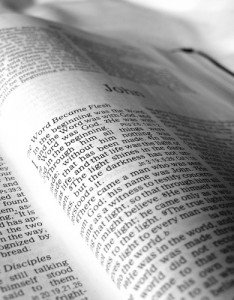As we gather for worship, we know we will hear God’s word proclaimed. At times I’ve heard readings from the Bible in a dull monotone, devoid of interest for the speaker and hard to hear for listeners; at other times I have been held on the edge of my seat, spellbound, as the lesson has come alive from being shared so well.
Hearing God’s word in liturgy isn’t just about the gifts and preparation of the lector, but it’s also about how that word is prepared for our use. Few of us in Canada are fluent in the Koine Greek of the New Testament or the Hebrew of the Hebrew Scriptures, and so we depend upon translations. We need them to be accurate and accessible, revealing the depth of the meanings of each passage and being able to sound well when read aloud.
I’ve heard the Bible read from a number of different translations (and, on Pentecost for the Acts lesson, even in several languages simultaneously). What is perhaps not well known is that we have in the Anglican Church of Canada a “List of Bible Versions Approved by the House of Bishops for Use in Public Worship in the Anglican Church of Canada, on Recommendation from the Doctrine and Worship Committee.” Last revised in 1991, the list approves these translations:
- New Revised Standard Version
- Revised English Bible
- King James (Authorized Version)
- Revised Standard Version (and its revision as Common Bible)
- New American Bible
- Today’s English Version (Good News)
- New International Version
- New Jerusalem
And as you read this post, another quite new version is being given serious consideration. It’s called the Common English Bible (CEB), and is an attempt to produce what its website describes as a “smooth and natural reading experience.” It tries to offer a clear translation that people will want to read themselves and hear read in worship.
The CEB is the culmination of the work of 118 translators from twenty-two different denominations and faith backgrounds, plus editors and readability experts. Their efforts were sponsored by a consortium of denominational publishers (from the Disciples of Christ, the Presbyterian Church U.S.A., the Episcopal Church, the United Church of Christ, and the United Methodist Church).
So if we as the church in this part of the world are considering using a new translation, what sorts of questions are we asking? It may be helpful to remember that local communities (like parishes, etc.) are encouraged by our House of Bishops to choose “a translation suitable for their needs and purposes” considering a variety of criteria:
- the nature of the local community (cultural profile, education, etc.)
- fidelity of translation to the original text
- no gratuitous use of exclusive language
- intelligible in terms of contemporary English use
- natural use of language
- coherence with the language of the liturgy itself
- does the translation give help with the pronunciation of proper nouns?
Some of these criteria will be more important than others in different communities, but this list does help us to consider some of what’s important in how the word of God comes alive as we worship. [The instruction from the House of Bishops also offers clear guidance about what not to use, such as paraphrases (like The Message) or translations of translations (like The Living Bible). Perhaps the most interesting and subjective of these is that a criterion for exclusion is “Translations in colloquial rather than contemporary English.”]
There’s any manner of other questions worth asking as we think about this new version. We might wonder about theology: for two examples, what difference does it make that the CEB uses “Human One” in place of the more familiar but enigmatic “Son of Man”? Or “Lord of Heavenly Forces” in place of “Lord of power and might”?
As I think about the new Common English Bible translation, the most important question for me is, do I want to hear this version read aloud in Church Sunday by Sunday? Put another way: what would it be like to hear this version read in church from the lectern, and what advantages and disadvantages does this version have?
We’ve put up a page with seven example passages taken from the CEB, beside their NRSV equivalents, which you can look at here; and you can look up any passage you would like to from the CEB at http://www.commonenglishbible.com/
What leaps out at you? Would it be a good possible translation for us as the Anglican Church of Canada to use? Why or why not?


By Charlie October 3, 2012 - 1:10 am
This seems to be an interesting — no sarcasm intended — on ‘reading which Bible in church’. I had expected a discussion on something I’m afflicted with several, well, three Sundays a month when the Bible isn’t so much ‘read’ to us as ‘mumbled’at us. (The remaining times we, the choir-members do the job which means the words are properly enunciated and given appropriate volume control. Fortunately there is some high-tech system of projecting the text of the reading onto the left and right walls so we can -read -the lessons – in order that we may “mark, learn and inwardly digest ” that which was written for us.
So there are my thoughts on Reading the Bible in Church.